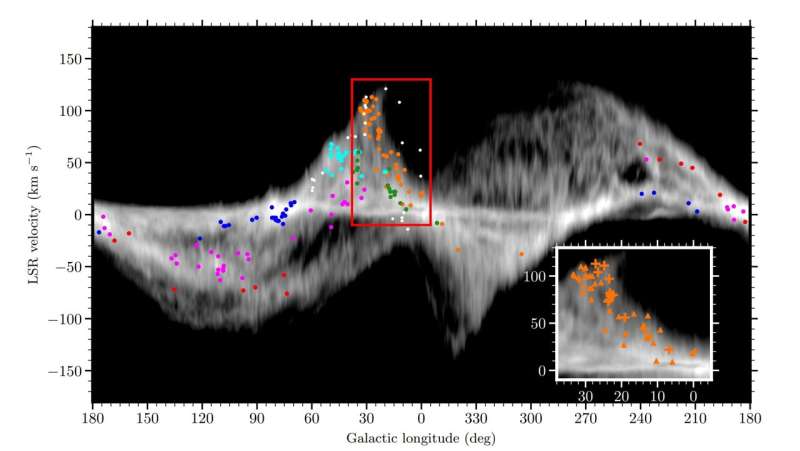May 1, 2023 report
This article has been reviewed according to Science X's editorial process and policies. Editors have highlighted the following attributes while ensuring the content's credibility:
fact-checked
peer-reviewed publication
trusted source
proofread
New measurements suggest rethinking the shape of the Milky Way galaxy

A team of space scientists with the Chinese Academy of Sciences, at both the Purple Mountain Observatory and the National Astronomical Observatories, has found that the traditional view of the Milky Way galaxy as having four arms is not correct. In their paper published in The Astrophysical Journal, the group describes their analysis of multiple sources of data in an attempt to gain a true shape of the Milky Way.
For many years, space scientists have imagined the Milky Way galaxy as a spiral shape with a central bulge and four main spiraling arms—with several other smaller branching arms. Over the past several years, telescope technology has improved and along with it, the realization that the vast majority of galaxies conform to just one of three main shapes: spiral, irregular and elliptical. Also, most have two main arms with spirals splitting into smaller arms.
Such splitting is believed to have occurred due to collisions with other galaxies or clusters. Such observations suggest that if the Milky Way is a spiral galaxy with four arms, it would be extraordinarily rare. And if that were the case, there would have to be some unique attributes that would have led to such a unique shape. The researchers with this new effort suggest it is more likely that we got the shape wrong from the start. They believe that, like most other galaxies, the Milky Way has just two main arms.
The research team came to this conclusion by analyzing data from a new generation of space instruments, all of which have technology that allows for measuring how far individual stars are away from us. One such instrument, the team notes, has long baseline interferometry, which can very accurately measure the distances to stars that emit microwaves. They used it to measure 200 such stars which they used to start building a map of the Milky Way.
The team also used data from the Gaia space observatory, which is used to map the location of stars in relation to Earth and one another. They focused their attention on O-B stars, which have been found to be useful because they do not move much after formation. They gathered data on 24,000 of them and added them to the map they were building. They also added data for nearly a thousand open cluster stars, also courtesy of Gaia.
The team then fit the arrangement of the stars to a spiral and, in so doing, found that that the most likely shape of the Milky Way is a barred spiral with two main arms that stretch outwards from the bar. Other shorter arms are more distant and irregular and are not connected to the main structure.
More information: Y. Xu et al, What Does the Milky Way Look Like?, The Astrophysical Journal (2023). DOI: 10.3847/1538-4357/acc45c
Journal information: Astrophysical Journal
© 2023 Science X Network



















